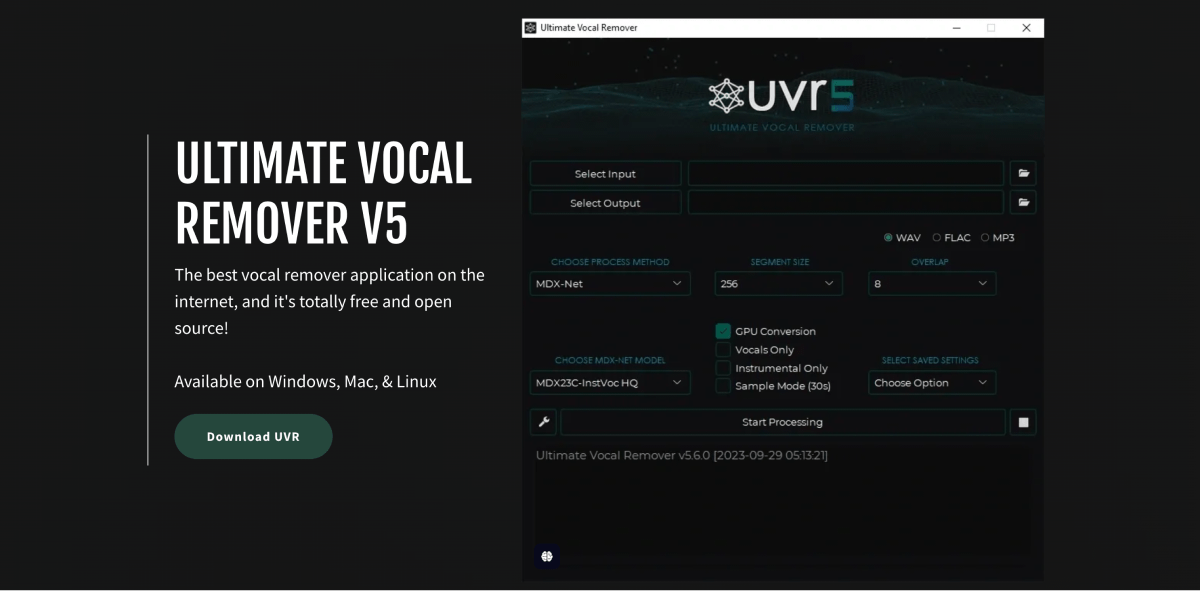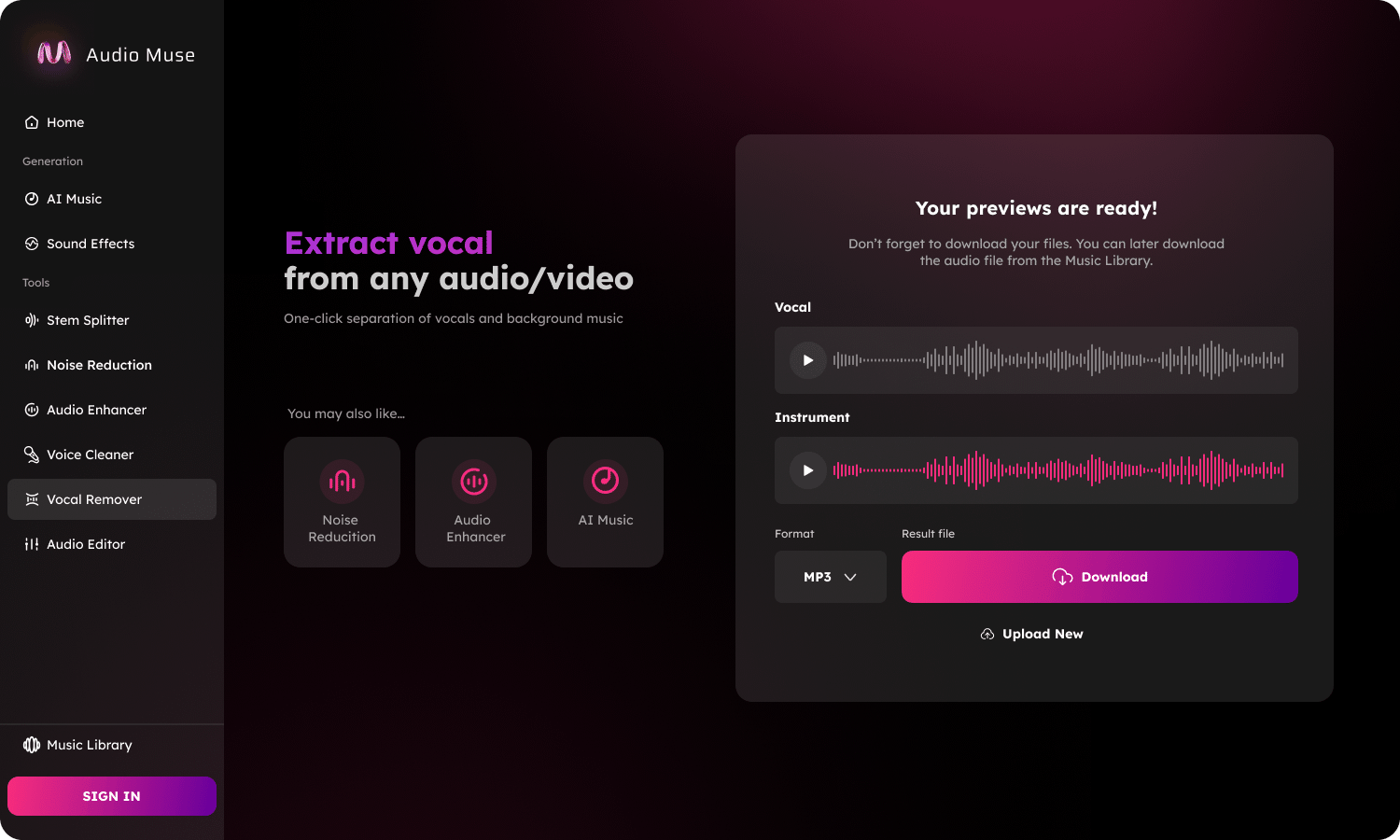2025 Demucs vs Ultimate Vocal Remover: The Ultimate Guide to Audio Source Separation
2025 Demucs vs Ultimate Vocal Remover: The Ultimate Guide to Audio Source Separation
Blog Article

In the realm of music production and editing, separating specific tracks such as vocals or instrumental parts from a song is both common and challenging. With advancements in AI technology, several tools have emerged to make this process easier. Today, we delve into two of the most popular audio separation tools - Demucs and Ultimate Vocal Remover (UVR), exploring their features, advantages, limitations, and finally, introducing Audiomuse's Vocal Remover with an emphasis on its online accessibility and ease of use.ai vocal remover
Introduction to Demucs
Demucs (Deep Extractor of Music Components Using Convolutional Neural Networks) is an open-source project designed for high-quality audio source separation. It separates audio files into multiple components like drums, bass, other instruments, and vocals. Demucs stands out due to its powerful model training capabilities and support for complex audio structures, making it versatile across different genres of music.

Try Now!Demucs
- Supports multi-track separation
- Highly customizable, allowing users to adjust parameters for optimal results
- Open-source with an active community contributing to continuous improvements
Introduction to Ultimate Vocal Remover
Ultimate Vocal Remover (UVR) focuses on removing vocals from audio tracks. Utilizing advanced AI algorithms, UVR aims at isolating background music by eliminating vocal elements. While primarily used for vocal removal, it also offers enhancements such as equalizer adjustments and noise reduction to improve the quality of separated audio.
- Specifically designed for vocal removal, offering straightforward usability
- Provides additional tools like EQ adjustments and noise reduction for further enhancing the audio quality
- Compatible with various audio formats and accessible directly through browsers without requiring additional installations

Try Now!ultimatevocalremover
Comparative Analysis
To better understand how these tools compare against each other, let's break down their features in a detailed comparison table:
Feature/Criteria Demucs Ultimate Vocal Remover (UVR) Primary Use Case Multi-track separation Vocal removal Ease of Use Requires some setup and customization Very user-friendly Customization Options Extensive options for tweaking Limited customization Supported Formats Various formats supported Multiple formats including MP3, WAV, etc. Accuracy in Complex Mixes High accuracy in separating complex mixes Good accuracy in simpler vocal removal tasks Processing Time Varies depending on complexity Generally faster Community & Support Active open-source community Growing but smaller community Cost Free Free
Detailed Comparison
- Purpose and Scope
- For comprehensive audio separation needs beyond just vocal removal, Demucs provides a more robust solution.
- If your primary goal is to remove or isolate vocals efficiently, UVR offers a streamlined approach tailored specifically for that purpose.
- Usability
- The flexibility of Demucs comes at the cost of requiring more initial setup and understanding of its parameters.
- Conversely, UVR’s interface is designed for ease of use, ideal for quick operations without needing deep technical knowledge.
- Performance
- When dealing with intricate audio mixes, Demucs often delivers superior accuracy thanks to its sophisticated neural network models.
- However, for clear vocal and instrumental separations, UVR can achieve excellent precision and sometimes even quicker processing times.
Introducing Audiomuse's Vocal Remover
Finally, let’s introduce Audiomuse’s Vocal Remover, another player in the field of audio source separation. Designed with simplicity and efficiency in mind, Audiomuse allows users to upload their audio files online and select which stems they wish to extract or remove. Key features include:
Try Now!Vocal Remover
- Online Accessibility: No need to download any software; simply upload your file via the web platform.
- User-Friendly Interface: No need for advanced audio engineering knowledge. Just drag and drop your file, choose the desired stems, and let the software handle the rest.
- Multi-Format Support: Works with MP3, WAV, AAC, M4A, and more.
- Advanced Enhancements: Post-separation tools for EQ adjustments, noise reduction, and vocal enhancement are available right within the browser.
- Preview Functionality: Listen to the separated tracks before final export, ensuring you get the best possible result.ai vocal remover
Audiomuse combines the strengths of both Demucs and UVR, offering a balanced solution suitable for both beginners and professionals looking for reliable vocal removal and audio enhancement. Its online platform makes it especially appealing for those who prefer not to install additional software or deal with complex setups. Everything can be done directly from your browser, making the process incredibly convenient and efficient.
 Learn More:How to remove vocals from a song
Learn More:How to remove vocals from a songConclusion
Choosing between Demucs and Ultimate Vocal Remover depends largely on your specific needs. Whether you require a tool for detailed multi-track separation or one focused solely on vocal removal, there’s a perfect fit out there. Additionally, exploring Audiomuse’s Vocal Remover could provide an all-around solution that balances ease of use with powerful functionality, particularly emphasizing its online accessibility and user-friendly operation. Regardless of your choice, these tools represent significant advancements in making audio source separation more accessible than ever before.
Remember to consider factors like intended use, desired level of customization, and processing speed when selecting the right tool for your projects. Happy editing!
Frequently Asked Questions (FAQ) on Audio Source Separation Tools
Whether you're a music enthusiast or a professional audio engineer, using tools like Demucs, Ultimate Vocal Remover, or Audiomuse for separating audio tracks can sometimes raise questions. Here are some of the most frequently asked questions to help guide you through the process:
General FAQs
What is audio source separation?
Audio source separation refers to the process of isolating individual components (such as vocals, drums, bass, etc.) from a mixed audio track.
Which tool should I use for my project?
The choice depends on your specific needs. For comprehensive multi-track separation, consider Demucs. For straightforward vocal removal, Ultimate Vocal Remover might be more suitable. If you prefer an online solution with minimal setup, Audiomuse is a great option.
Demucs Specific FAQs
Is Demucs difficult to use?
No, most AI-based tools including Demucs are designed to be user-friendly. You typically need to upload your audio file, select which stems you want to extract or remove, and let the software handle the rest.
What formats does Demucs support?
Demucs supports various formats such as MP3, WAV, FLAC, AAC, and M4A. Always check the specific requirements of the tool version you are using.
How accurate is Demucs in separating tracks?
The accuracy varies based on the quality of the source material and the complexity of the mix. Demucs can achieve high accuracy, especially in complex mixes with distinct instrument parts.
Ultimate Vocal Remover Specific FAQs
Can Ultimate Vocal Remover remove all types of vocals?
UVR is highly effective at removing clear and distinct vocals but may struggle with very complex mixes where vocals are heavily overlapped with other instruments.
Does UVR offer any post-processing features?
Yes, after separating the tracks, UVR offers additional features like EQ adjustments, noise reduction, and vocal enhancement to further polish the isolated elements.
Is there a limit to the length of the audio file that UVR can process?
While UVR can process long audio files, processing times will vary depending on the length and complexity of the audio. There may also be server-side limitations for web-based applications. Report this page